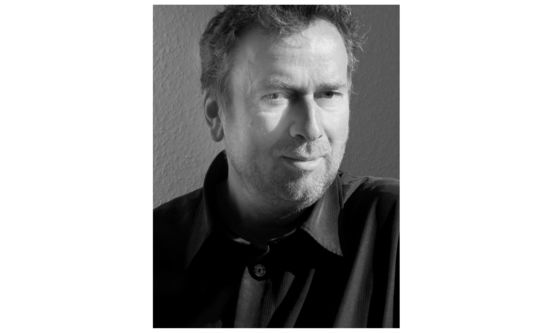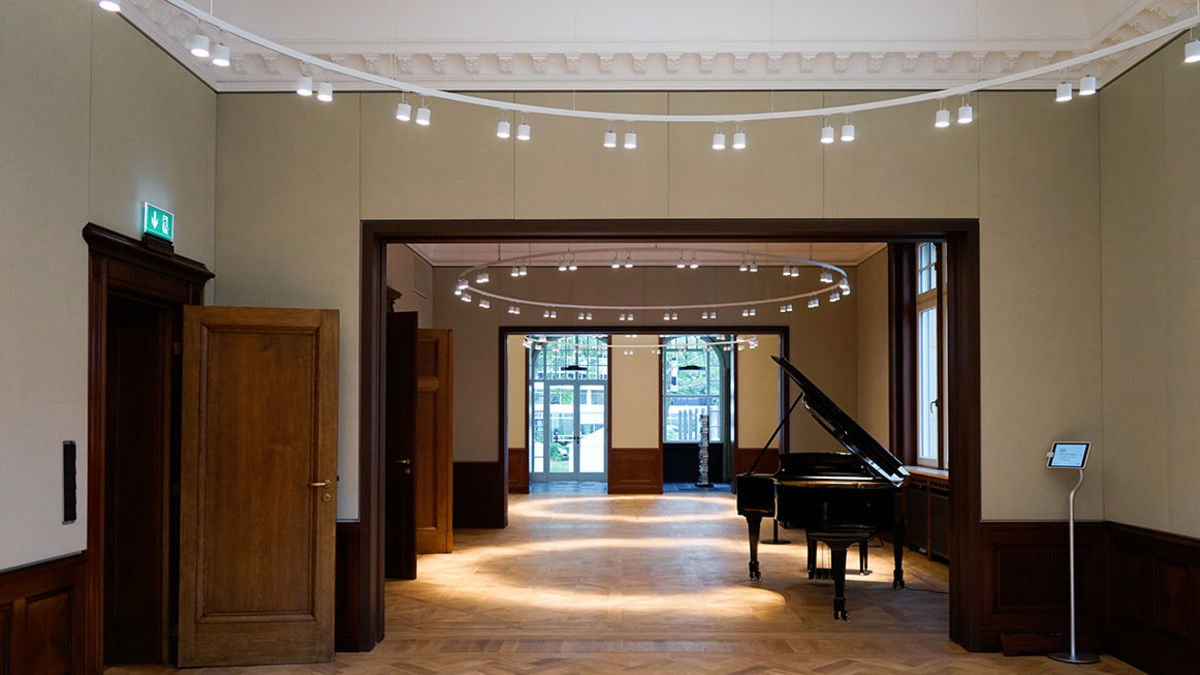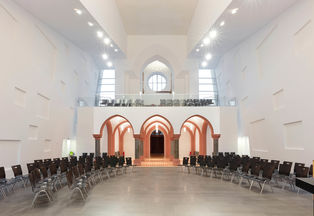- News,
- Stories,
- People
Mailänder Licht Design
“Mailand” is the German word for “Milan” – which immediately triggers associations with design – bearing the surname Mailänder (English: Milanese) could indeed mean one is predestined to be a designer. In Dirk Mailänder’s case, he works with light. Dirk Mailänder is an architect and qualified electrician and has his lighting design practice in Cologne, where he designs the lighting for a wide range of both modern and historic buildings including renowned churches and museums. He has also developed lighting designs for the central station in Cologne, and for companies such as T-Mobile, Canyon or Stroer. Mailänder Licht Design has been cooperating with Buschfeld for years.

What does designing with light actually mean to you?
For me it is important to understand the essence of the respective architecture so that the light – and not the dominant presence of the luminaires – can develop its full effect and enhance the space in its original sense. What I don’t do is simply select a luminaire that might fit from a catalogue. I consider how the light can become part of the architecture, how it can be integrated into ceiling designs or architectural structures as part of the formal language of the space. I see it as my task to find out what and how the lighting is expected to complement the architecture. What is the space supposed to look like when lit, and what kind of atmospheres is the lighting supposed to generate? What is the main focus, what is it we want to see? How can a modern lighting design approach support a modern architectural approach? An exciting process indeed! And I also aim to get a feeling for which state-of-the-art luminaires and designs have a chance of being regarded as timeless. – We can only speculate, of course, but that is definitely one of my goals. After all, we want people to enjoy the projects we design ten or 20 years down the road. It is not about rapid consumption. Personally speaking, my key objective is to develop designs that last – and that is where our minds meet: Buschfeld and Mailänder share a very similar approach!
How do you go about developing a lighting design?
The first step for us is to undertake an in-depth analysis of the task at hand. Then we start to form an abstract idea. After that we develop a lighting concept: what kind of lighting is required to fulfil our goals? Direct or indirect lighting, wall-washing, accent lighting and focus on detail, and so on. Only then do we consider what luminaires we need to achieve the concept defined.
How has lighting design changed over the last few years?
Digital rules the roost nowadays, from planning stage through to realisation. As part of our work we do generate computer visualisations and use lighting calculation programmes. But to formulate a design process to a degree of perfection that the realisation of the project is based to a tee on a visualisation – that is not my way of going about it. Because things can be visualised that go far beyond the physical limits. Which is why we still like to jot our ideas and thoughts down on paper. This makes it a lot easier and simpler to communicate design ideas and the reasons behind them later on as part of the process. This classic approach can be exciting since it is open for change and modification – it is indeed part of the process: first sketch out an idea and then work towards the real outcome step by step. It may well turn out that the initial proposal is in theory a good one. But it is also possible that we are faced with some challenging surprises. Basing our discussions on hand-drawn sketches we – and the client – are not obliged to stick resolutely to an appealing visualisation.
What has changed in the lighting industry?
Today we have completely different and highly diverse possibilities when it comes to lighting. Reflector technology alone has developed incredibly. Take the lighting we design for churches, for example: we have managed to design and install lighting solutions so that visitors are no longer subjected to glare in places of worship. Instead, they are able to perceive and appreciate the architecture, as is the case in the gently illuminated mediaeval cloister in the Bonn Minster. Today it is possible to apply lighting technology to truly shape the architecture. Space and history are able to connect to an optimum. Culture can be portrayed and communicated far more effectively!
That sounds pretty complex...
There are a variety of different lighting requirements that need to be taken into account in a project, and often even in just one space. In modern office environments light is not only needed for working purposes. After 5 p.m. the staff also require the right light to help them relax a little after a day of concentration at their workstations. Hybrid forms of use, so to speak. Lighting for churches today, for example, ranges from delicate candlelight to brightly lit scenarios of a celebratory nature. Because churches are used for a variety of cultural activities. When a huge choir stages a performance there, we are required to provide the kind of lighting suitable for a concert hall. Completely different from the lighting required for a church service. – That is to say we have to be totally aware of the different usages of the space from the start so that the lighting design can accommodate changing requirements.
What does a realised project have to look like for you to admit you are satisfied?
I like it when the result is not only focussed on the lighting solution, but when the architecture allows different lighting atmospheres to be generated. What I aim to do is deliver a range of lighting options from subtle, warm atmospheres to enhanced clarity and brightness.
I don’t consider myself to be a specialist. I think about the overall project in a broader sense.
How long have you been cooperating with Buschfeld?
I got to know Hans Buschfeld at Expo 2000 in Hanover. He had developed a massive luminous wall for the VIP area. And what still delights me to this day is having Buschfeld as a partner with whom I can creatively exchange ideas. – We need such lighting manufacturers. Companies who are not merely out to sell what is in their catalogues, but are also interested in developing innovative ideas to create a completely new product. And that works extremely well with Buschfeld!
What projects are you working on together right now?
For example, KfW’s newly refurbished Villa 102 in Frankfurt, formerly referred to as the “House of Literature”. An extremely successful project, often frequented by high-ranking politicians. The villa dates back to the Gründerzeit, the age of industrialisation in Central Europe, and features a lot of stucco work that has been renovated with care over the years. In this case, too, the challenge was to light the individual rooms so that they could meet the different needs they were designed to cater for: on the ground floor four rooms for representative purposes, upstairs a large conference space and two smaller exhibition spaces. – We opted to apply the Buschfeld system given that its discreet, minimalist design enables it to be integrated unobtrusively into the architecture. At the same time, it offers high-performance lighting. Together we created an innovative solution: Buschfeld luminaires mounted in three ring-shaped sections of track, each with a diameter of 3.80 metres, providing the quantity and quality of light that would not have been possible five years ago.
How do you envisage the future of lighting design?
The minimisation of lighting technology is a continuous and lengthy process for sure. – It can’t get much smaller than it is now, though. What we need is a large portion of sensitivity and common sense: as lighting designers, we need to train ourselves to better comprehend the effect daylight and artificial light after dark have on us. Hazy, diffuse daylight or bright sunshine affect our inner selves. The kind of moods and atmospheres we associate with natural light are also possible to achieve using electric light. You have to remember that when you design lighting!
Interview: K. Spohr



